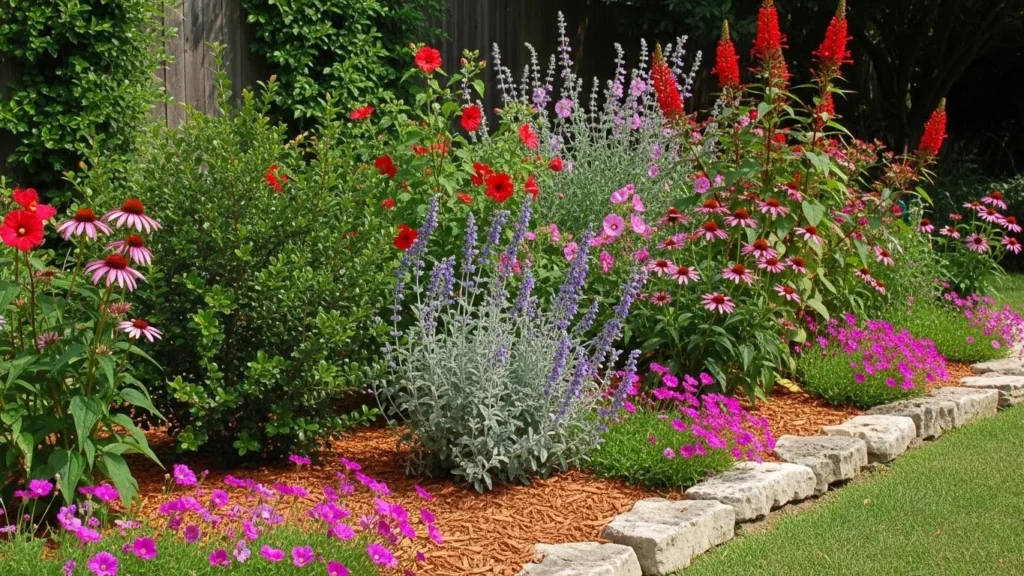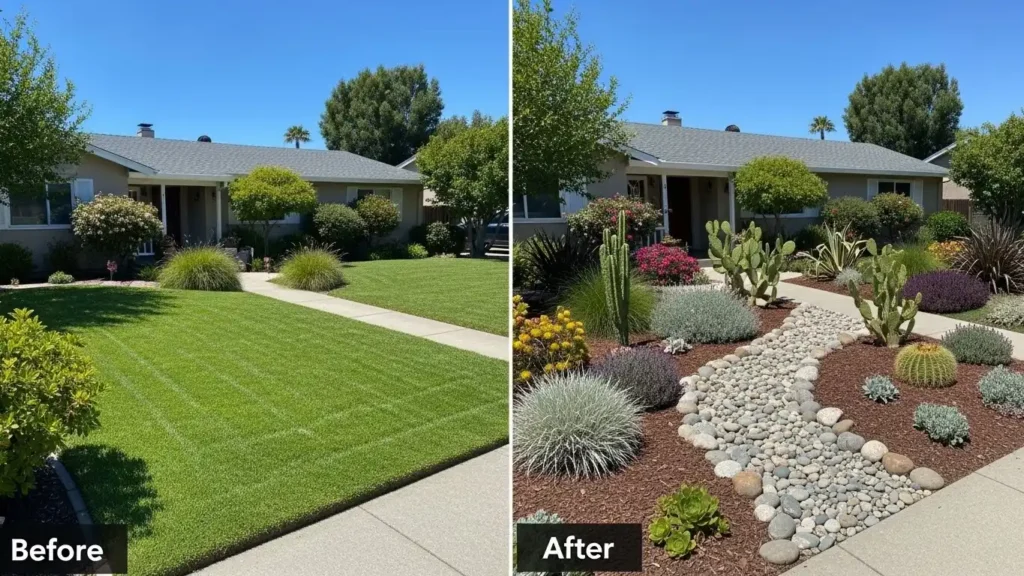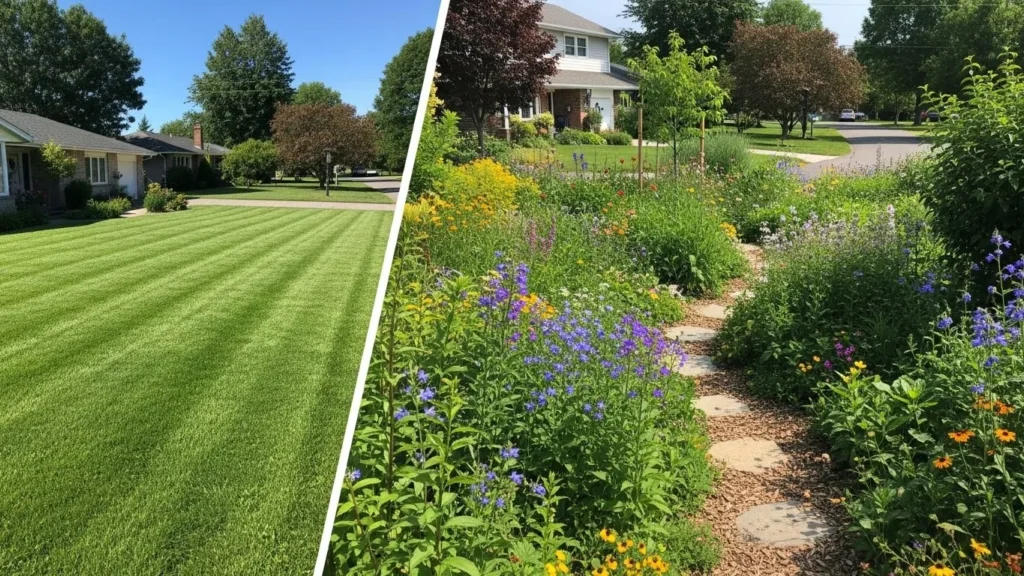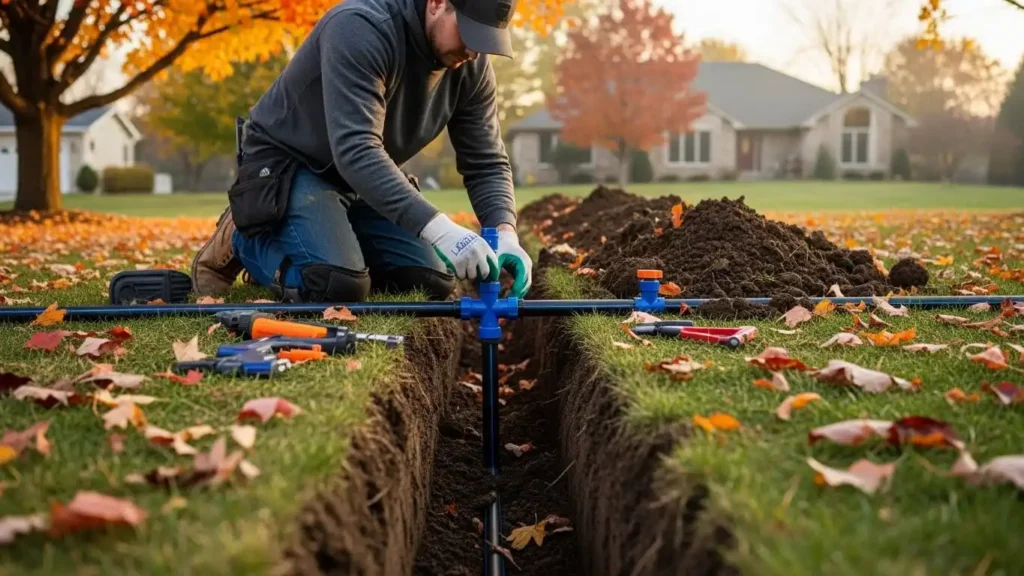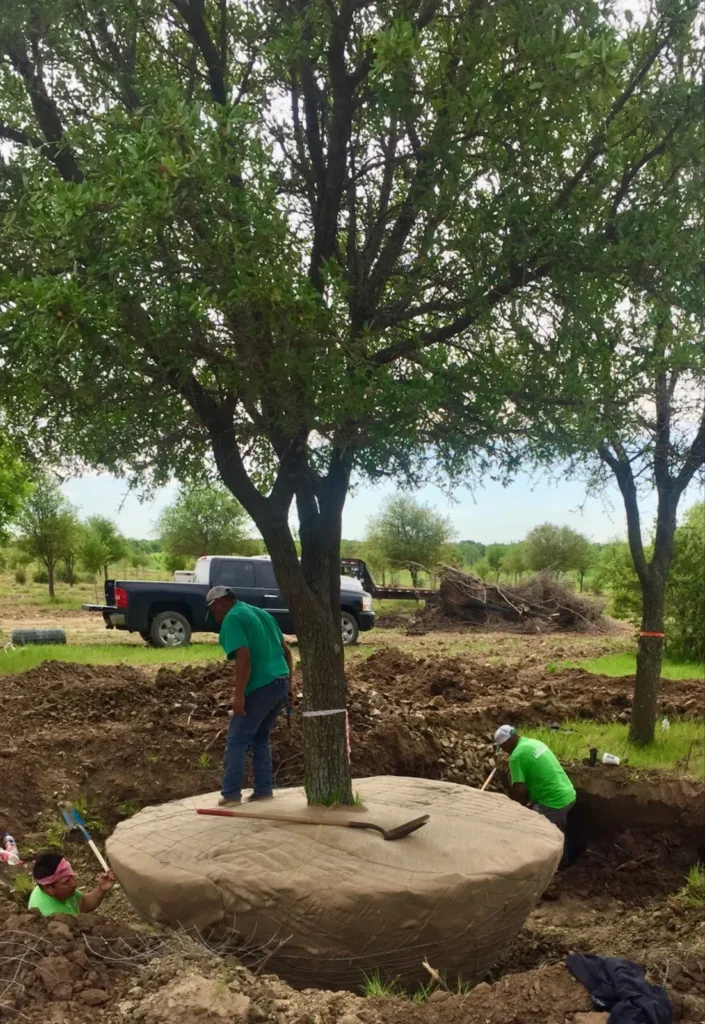Table of Contents
ToggleIntroduction — Why Choose Natives for Central Texas
Native plants are the easiest, most sustainable way to create attractive, resilient landscapes in Central Texas. They’re adapted to hot summers, variable rainfall, and local soils—which means less water, less fertilizer, fewer pesticides, and more wildlife value. A native-first approach reduces maintenance while delivering distinct seasonal interest and strong ecological benefits.
Best Native Trees for Shade & Structure
Choose a mix of long-lived canopy trees and smaller ornamentals for a balanced landscape.
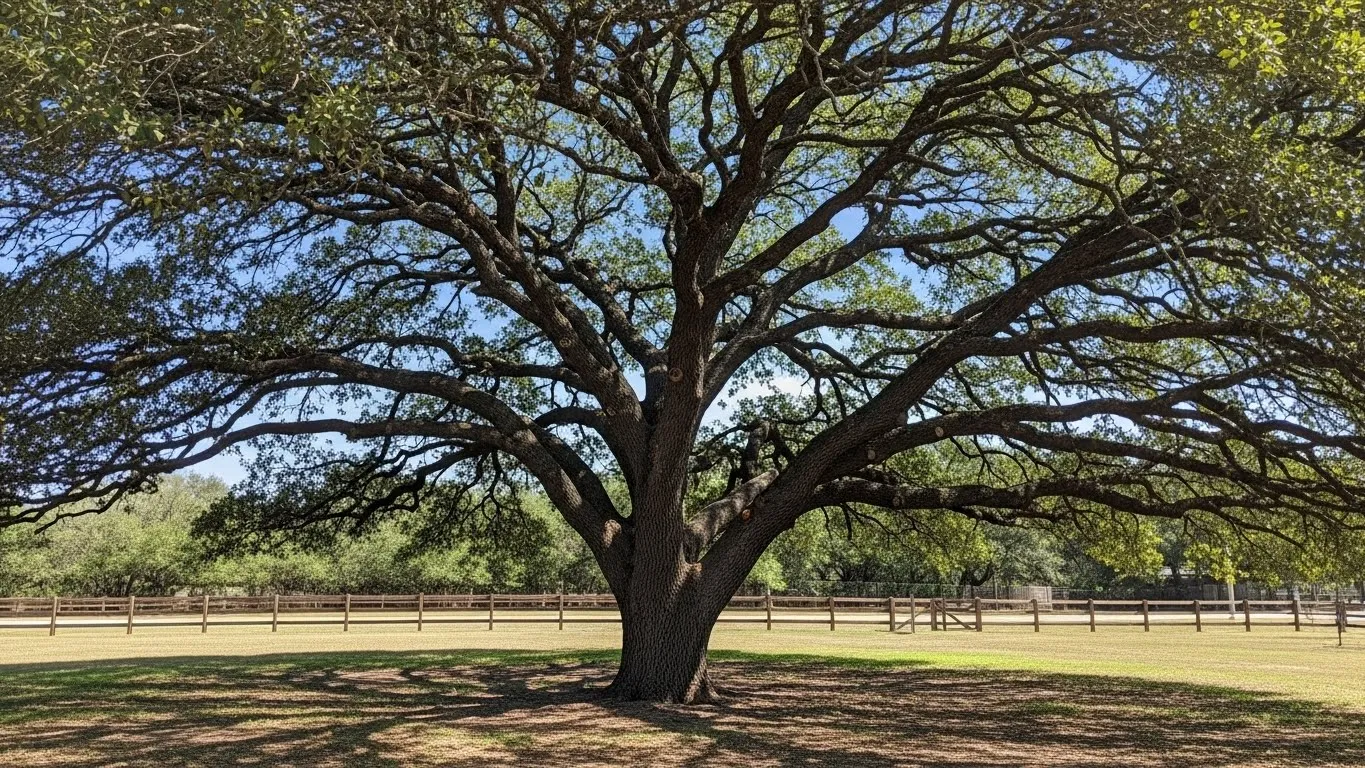
The Texas Live Oak is a signature shade tree for Central Texas landscapes.
- Texas Live Oak (Quercus fusiformis): A large, evergreen canopy tree that provides excellent shade and tolerates clay soil. Matures at 30–60’+.
- Cedar Elm (Ulmus crassifolia): A fast-growing, tough tree ideal for yards and streets. Tolerates compacted soils and reaches 40–60′.
- Shumard Oak (Quercus shumardii): A handsome deciduous red oak with reliable fall color. Prefers deeper soils and grows to 40–70′.
- Texas Redbud (Cercis canadensis var. texensis): A small flowering tree (15–25′) with brilliant magenta spring blooms, perfect near patios.
- Mexican Plum (Prunus mexicana): Offers fragrant spring flowers, small edible plums for wildlife, and good fall color. Matures at 15–25′.
Native Shrubs for Seasonal Interest & Wildlife Value
Shrubs provide mid-level structure, beautiful flowers, and berries for birds.
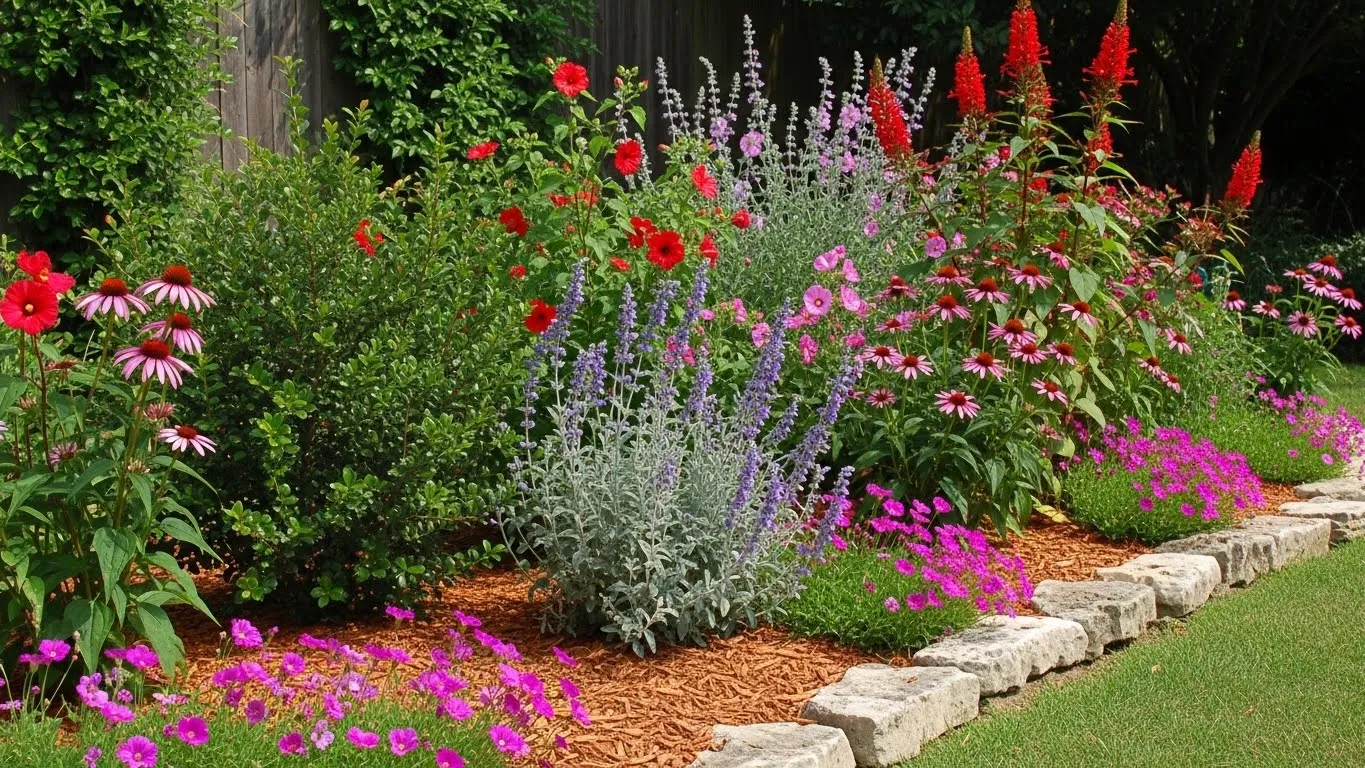
Native shrubs like Texas Sage and American Beautyberry provide color and wildlife food.
- Texas Sage / Cenizo (Leucophyllum frutescens): Features silver foliage and bursts into purple blooms after summer rains. Extremely drought-tolerant.
- American Beautyberry (Callicarpa americana): Known for its stunning clusters of magenta berries in the fall, a favorite for birds.
- Yaupon Holly (Ilex vomitoria): A versatile evergreen with bright red berries on female plants. Excellent for hedges and screening.
- Rock Rose (Pavonia lasiopetala): A long-blooming perennial shrub with hibiscus-like pink flowers that attract pollinators.
- Turk’s Cap (Malvaviscus arboreus): A shade-tolerant favorite of hummingbirds with unique red, turban-like flowers.
Native Perennials for Color and Pollinators
Perennials provide recurring seasonal blooms and are a critical food source for pollinators.
- Autumn Sage (Salvia greggii): A long-blooming hummingbird magnet available in many colors, including red, pink, and white.
- Blackfoot Daisy (Melampodium leucanthum): A tough, low-growing plant covered in honey-scented white daisies from spring to fall.
- Gregg’s Mistflower (Conoclinium greggii): Produces clouds of fuzzy blue-purple flowers in late summer, irresistible to butterflies.
- Mealy Blue Sage (Salvia farinacea): Features tall, sturdy spikes of blue or white flowers that persist through the heat.
Native Grasses, Groundcovers & Succulents
These plants add texture, create architectural interest, and stabilize the soil.
- Little Bluestem (Schizachyrium scoparium): A beautiful clumping grass with blue-green summer foliage that turns a coppery-orange in fall.
- Gulf Muhly (Muhlenbergia capillaris): Famous for its airy, pink-purple plumes that create a stunning cloud-like effect in autumn.
- Frogfruit (Phyla nodiflora): A tough, low-growing groundcover that tolerates light foot traffic and hosts butterfly larvae.
- Sotol, Yucca, & Agave: A wide variety of species that provide strong, architectural forms and are extremely drought-hardy.
Plant Selection Matrix (Quick Reference)
| Plant | Sun | Soil | Water | Deer Tolerance |
|---|---|---|---|---|
| Live Oak | Full sun/Part shade | Clay/Loam | Low (once established) | High |
| Texas Sage | Full sun | Well-drained/Rocky | Very Low | High |
| Autumn Sage | Full sun | Well-drained | Low | Moderate |
| Little Bluestem | Full sun | Adaptable | Very Low | High |
Step-by-Step Planting & Establishment Guide
- Site Prep: Remove all weeds and grass. For heavy clay, incorporate a small amount of compost into the backfill soil.
- Digging: Dig a hole 2-3 times the width of the root ball but no deeper than its height. The top of the root ball should be slightly above the surrounding soil level.
- Planting: Gently place the plant in the hole. Backfill with the native soil, ensuring there are no air pockets.
- Mulch: Apply 2-3 inches of organic mulch, such as shredded hardwood, keeping it a few inches away from the plant’s stem or trunk.
- Watering: Water deeply and thoroughly after planting. For the first year, water deeply every 1-2 weeks during dry spells to encourage deep root growth.
FAQ
When is the best time to plant natives in Central Texas?
Fall is ideal. Cooler temperatures and autumn rains help roots establish before the stress of summer heat.
Do native plants need fertilizer?
Generally, no. They are adapted to local soils. A top-dressing of compost once a year is usually sufficient.
Conclusion & Call to Action
Building with native plants is the easiest route to a resilient and beautiful Central Texas landscape. Start with a site assessment, select plants for your specific conditions, plant in the fall when possible, and follow a simple establishment watering plan.
Written by Let Us Do It Landscaping (LUDI).
For help designing or installing a native landscape, contact us for a quote!
